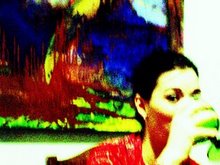
Curating. Just as I am interested in the intersections between the art, craft, and design worlds, so too am I interested in breaking the stereotypes of what it means to be a curator. Labels and stereotypes run rampant in the art world, and I feel compelled to dismiss, ignore, and criticize all of them. What does it mean to be an artist and a curator? I don't feel my position makes my art or my curating any less valid. After all, people are capable of more than one role in life. I'm a mother too--does my work as an artist and a curator make my parenting any less important?
Of course not.
There has been a lot of talk and criticism of the concept of curating as art. There are contemporary curators like
Hans Ulrich Obrist and
Ydessa Hendeles that create unique exhibitions that some people consider art (or at least creative). I don't see anything wrong with this. After all, curators are now coming from various backgrounds--no longer simply art historians--curators like me have something to actually contribute, not just intellectualize, organize, and install.
The group show is most conductive to this type of curating. My exhibitions will be based on curatorial premises or concepts. When I think of an idea for a show, it is very similar to when I think of an idea for artwork. That is not to say that there isn't a distinction between curating and art. One artist working somewhat within the scope that I am talking about is
Julieta Aranda who created projects such as
Pawnshop and E-flux
video rentals.
Visit the
E-flux website for more interesting info & projects
For more that I've written on this subject, visit
Visual Influence.I've only scratched the surface here--if you are interested in this subject I would recommend the current issue of
Art Lies, which includes several in-depth articles on
Death of the Curator.As always, I would be interested in your thoughts--feel free to comment or e-mail me.



























